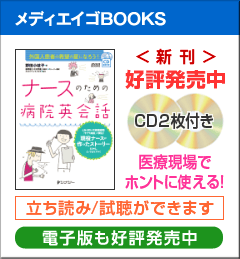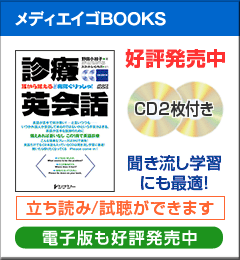

医学にも詳しいバイリンガル・パーソナリティのスマイリーが,ホットな話題を英語のニュースリリースを元に紹介する音声(ポッドキャスト)番組です。完全なネイティブではない,ちょっとくせのあるパワフル英語がやみつきになるかもしれませんよ。番組で取り上げるニュースリリースの全文も掲載しているので,ぜひご活用ください。
英語と日本語のチャンポンで不定期にお届けします。
Please enjoy this bilingual news program!
※iPhone, iPadでは「Download」をタップすると音声が出ます。
Jan. 28, 2013
No. 9
米国心臓協会年次学術集会より:“老け顔”の人は心疾患にご用心?!
老け顔の人では虚血性心疾患の発症リスクが上昇
|
Get the Flash Player to see this player.
|
 |
・aging sign:老化現象
・receding hairline:髪の生え際の後退
・yellow fatty deposit:黄色い脂肪の塊
【番組で取り上げた英文】
In a new study, those who had three to four aging signs had a 57 percent increased risk for heart attack and a 39 percent increased risk for heart disease.
-receding hairline at the temples, baldness at the head’s crown, earlobe crease, or yellow fatty deposits around the eyelid.-
Individually and combined, these signs predicted heart attack and heart disease independent of traditional risk factors. Fatty deposits around the eye were the strongest individual predictor of both heart attack and heart disease.
Heart attack and heart disease risk increased with each additional sign of aging in all age groups and among men and women. The highest risk was for those in their 70s and those with multiple signs of aging.
The visible signs of aging reflect physiologic or biological age, not chronological age, and are independent of chronological age. Checking these visible aging signs should be a routine part of every doctor’s physical examination.
【ニュースリリース全文】 ※番組で取り上げた箇所は太字になっています。
News Release from American Heart Association on November 6, 2012
Telltale visible signs of aging may predict heart disease
LOS ANGELES, Nov. 6, 2012 -- If you look old, your heart may feel old, according to research presented at the American Heart Association’s Scientific Sessions 2012.
In a new study, those who had three to four aging signs — receding hairline at the temples, baldness at the head’s crown, earlobe crease, or yellow fatty deposits around the eyelid (xanthelasmata) — had a 57 percent increased risk for heart attack and a 39 percent increased risk for heart disease.
“The visible signs of aging reflect physiologic or biological age, not chronological age, and are independent of chronological age,” said Anne Tybjaerg-Hansen, M.D., the study’s senior author and professor of clinical biochemistry at the University of Copenhagen in Denmark.
Researchers analyzed 10,885 participants 40 years and older (45 percent women) in the Copenhagen Heart Study. Of these, 7,537 had frontoparietal baldness (receding hairline at the temples), 3,938 had crown top baldness, 3,405 had earlobe crease, and 678 had fatty deposits around the eye.
In 35 years of follow-up, 3,401 participants developed heart disease and 1,708 had a heart attack.
Individually and combined, these signs predicted heart attack and heart disease independent of traditional risk factors. Fatty deposits around the eye were the strongest individual predictor of both heart attack and heart disease.
Heart attack and heart disease risk increased with each additional sign of aging in all age groups and among men and women. The highest risk was for those in their 70s and those with multiple signs of aging.
In the study, nurses and laboratory technicians noted the quantity of gray hair, prominence of wrinkles, the type and extent of baldness, the presence of earlobe crease and eyelid deposits.
“Checking these visible aging signs should be a routine part of every doctor’s physical examination,” Tybjaerg-Hansen said.



